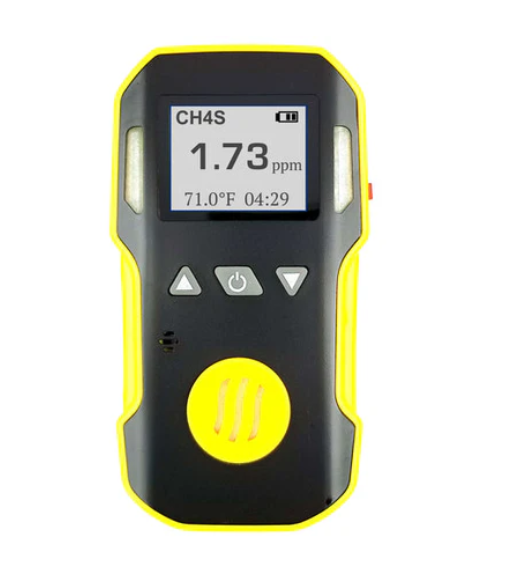A Mercaptan gas detector is vital when dealing with mercaptan, a toxic gas known for its pungent skunk, garlic, or rotten odor. This distinctive smell makes mercaptan a warning agent in natural gas and petrochemical products. While useful in pharmaceuticals, livestock feed, fungicides, and plastics, mercaptan exposure is hazardous. Mercaptan Gas Detectors are crucial for detecting this toxic gas and preventing harmful exposure. Industries must employ reliable gas detection methods to utilize mercaptan safely while prioritizing employee health and environmental well-being. Gas detection ensures the safe use of mercaptan in various applications while minimizing risks associated with this pungent and toxic substance.
Pros |
Cons |
|
✅ Mercaptan gas can be detected by a human down to 1 part per billion (1ppb), low human odor threshold ✅ A Mercaptan gas detector can detect the amount of CH2S present to limit gas exposure danger ✅ A Mercaptan gas detector is useful in livestock feed, plastics, petrochemical industry and sanitization |
⛔ Mercaptan gas detectors are expensive ⛔ Do not confuse Ethyl and Methyl Mercaptan ⛔ Mercaptan gas detectors need regular calibration and bump testing ⛔ It has a terrible putrid smell making hard to work with |
Best Mercaptan Gas Detector?
There are a variety of mercaptan gas detectors on the market. They can be purchased from several online retailers. Some examples of reputable CH4S gas detectors include:
- Forensics Detectors Mercaptan Gas Detector
- Sensidyne Mercaptan Gas Detector Tubes
- Delphian Methyl Mercaptan Fixed Gas Monitor
- Detcon Wall Mount Mercaptan Gas Monitor
- Korno Methanethiol Gas Detectors
What are the Mercaptan Gas Names?
The common mercaptan, is also known as Methyl Mercaptan, Mercaptan, Mercaptanthiol. Its chemical formula is CH4S sometimes written as CH3SH, MeSH. There is also Ethyl Mercaptan, which is Ethanethiol and a different gas with the chemical formula C2H4S. Make sure not to confuse them - but both has a very pungent smell.
What is Methyl Mercaptan Used For?
-
The single biggest use of CH4S is for production of synthetic methionine as a chicken feed supplement. Methionine is an amino acid used to make protein.
- Used in industrial situations to produce pesticides, fungicides, plastics and animal feed additives.
- In the natural world, it is found near decaying organic matter and thus found in natural gas, crude oil and some coal tar deposits.

Why are Mercaptan Gas Detector becoming useful?
More demand for mercaptan gas detectors is increase because the market demand for the methyl mercaptan is also growing. This is due to its application in the poultry and livestock feed as a result of growing popular and food demand. Other Mercaptan gas detector demand is coming from applications in pesticide and fungicide industries, applications in mining operations for communication, jet fuel additives.
What is in a Mercaptan Gas Sensor?
Like most gas detectors, a CH4S gas detector is composed of several key parts which includes the sensor, computer and display. The mercaptan gas sensor is critical to detecting the presence of CH4S gas molecules. The gas causes a chemical reaction in electrochemical sensors, resulting in a current that is directly proportional to the gas concentration present. The sensors consume extremely little power and respond well to a variety of gas concentrations across a wide range of environmental conditions.

Is Methyl Mercaptan Gas Poisonous?
Yes.
Based on the CDC, CH4S gas is highly irritant when it contacts moist tissues such as the eyes, skin, and upper respiratory tract. It can also induce headache, dizziness, nausea, vomiting, coma, and death.
At very high concentrations it is highly toxic with a impressive odor threshold of 1 ppb being reported.The United States OSHA Ceiling Limit is listed as 10 ppm. NIOSH REL is 0.5ppm.
Have There Been Mercaptan Accidents?
Yes there have been. Some notable incidents includes:
- In 2022, South Jersey experienced a mercaptan leak and sickened many people.
- In 2014, the Du Pont company experience a methyl mercaptan leak killing 4 workers
- In 2001, a rail cart exploded with methyl mercaptan killing several people.
What are the Mercaptan Sensor Interference Gases?
Unfortunately, electrochemical sensors are not completely selective, and they respond to other gases present in the environment.
For mercaptanthiol, it has a strong cross sensitivity to H2S. See the table below.

How Can I Calibrate a Methyl Mercaptan Detector?
Although methyl mercaptan standards are not available for calibration, H2S gas standards can be utilized because a CH4S gas sensor responds 1:2 to H2S. This ratio may change slightly with different sensor manufacturers and ranges.
What Does Methyl Mercaptan Smell Like?
Mercaptan has a very foul smell, some even say the worst pungent smell on the planet.
People often describe the smell similar to skunk, garlic or some type of rotten organic matter. It definitely has resemblance to other sulfur smells such as hydrogen sulfide H2S which is a common gas release in sewer and from biological decomposition.
Encyclopedia.com describes it as foul-smelling gas with the odor of rotten cabbage released from decaying animal and vegetable matter.
How is Methyl Mercaptan Gas Generated?
It is made by reacting of hydrogen sulfide with methanol. It is found in the natural world also in very small quantities.
Is Methyl Mercaptan Gas Explosive?
Yes it is explosive at %vol concentrations. For example, the lower explosive limit (LEL) is 3.9% and the upper explosive limit (UEL) is 21.8%.
What is the Biggest Use for Methyl Mercaptan Gas?
The single biggest use of CH4S is for production of synthetic methionine as a chicken feed supplement. Methionine is an amino acid used to make protein.

What Makes Up a Methyl Mercaptan Gas Detector?
Like most detectors, a mercaptan gas detector is composed of several key parts.
- The sensor: the sensor is critical to detecting the presence of the CH2S gas in the first place
- The output: after the sensor recognizes the presence of the mercaptan gas, it pushes that information to a different component that converts that concentration to a reading interpretable by people
- The energy supply: the energy supply allows the device to continue working. This can vary depending on if the detector is portable or fixed
Is Methyl Mercaptan and Ethyl Mercaptan the Same Gas?
No. They are similar but not the same.
Methyl Mercaptan, Mercaptan, Mercaptanthiol as the chemical formula of CH4S sometimes written as CH3SH, MeSH. Ethyl Mercaptan, also known as Ethanethiol is a different gas with the chemical formula C2H4S.
They are both alkylthiols with low olfactory odor thresholds and sulfurous sweaty, skunky aromas. A fun fact is that they are both found to make an important contribution to the aroma of wine.
Can You Smell Mercaptan?
Yes, mercaptan has a strong, distinctive rotten egg smell. It's intentionally added to natural gas to help detect dangerous leaks that would otherwise be odorless.
Final Words
Gas detection is essential when dealing with mercaptan, as humans can detect its pungent odor at just 1 part per billion (1ppb). Mercaptan gas detectors measure CH2S levels to limit exposure risks in industries like livestock feed, plastics, petrochemicals, and sanitization. Although expensive, these detectors help differentiate between ethyl and methyl mercaptan. Regular calibration and bump testing ensure accurate readings, while the putrid smell makes mercaptan challenging to work with. Despite the difficulties, gas detectors are crucial for maintaining safety and protecting workers from the hazards of this toxic substance, emphasizing the importance of reliable gas detection in mercaptan-related applications.
About the Author
Dr. Kos Galatsis ("Dr.Koz") is the President of FORENSICS DETECTORS, where the company operates from the scenic Palos Verdes Peninsula in Los Angeles, California. He is a subject matter expert on gas sensor technology, gas detectors, gas meters, and gas analyzers. He has been designing, building, manufacturing, and testing toxic gas detection systems for over 20 years.

Every day is a blessing for Dr. Koz. He loves to help customers solve their unique problems. Dr. Koz also loves spending time with his wife and his three children going to the beach, grilling burgers, and enjoying the outdoors.
Read more about Forensics Detectors.
Email: drkoz@forensicsdetectors.com
Phone: +1 424-341-3886

